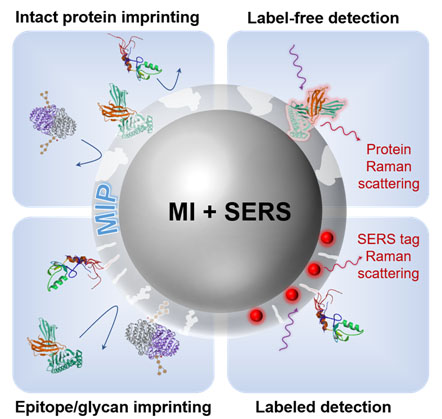摘要/Abstract

异常的蛋白质表达与疾病的发生与发展密切相关, 因此蛋白质已作为疾病标志物广泛应用于疾病的早期诊断、治疗监测和预后评估. 然而, 临床样本中的蛋白质疾病标志物通常含量极低, 并存在高丰度的基质干扰, 对检测方法的特异性和灵敏度提出挑战. 目前, 蛋白质疾病标志物的检测方法主要是免疫分析. 但是, 免疫分析主要依赖抗体进行特异性识别, 而抗体具有不易制备、稳定性较差和成本高等缺点. 同时, 免疫分析常通过荧光和化学发光等技术实现高灵敏检测, 但存在操作繁琐、光漂白、光谱宽等不足. 分子印迹聚合物已发展成为在特异性和亲和力方面可媲美抗体的仿生识别材料, 且具有容易制备、稳定性好和成本低等优势. 表面增强拉曼散射技术具有超高灵敏度、光谱窄、快速、无损检测等优势而广泛应用于化学和生物分析. 近年来, 分子印迹技术和表面增强拉曼散射技术的结合产生了系列先进的蛋白质检测方法, 展现了独特的优势, 受到了广泛的关注. 本综述旨在介绍该联用分析技术的主要进展, 在分别介绍分子印迹和表面增强拉曼散射及其在蛋白质检测中单独应用的基础上, 着重介绍基于两种技术的蛋白质疾病标志物的检测方法的研究进展. 最后, 对该联用技术的未来发展做了展望.
关键词: 分子印迹聚合物, 表面增强拉曼散射, 蛋白质, 检测, 疾病标志物
Abnormal protein expression closely correlates with the occurrence and development of diseases. Thus, proteins have been widely used as disease markers for early diagnosis, treatment monitoring and prognosis evaluation of diseases. However, protein biomarkers in clinical samples are usually present in extremely low concentration while the detection often suffers from severe interference by high-abundance sample matrix, which challenges the specificity and sensitivity of protein biomarker assay methods. Currently, the main detection method of protein biomarkers is immunoassay. Nevertheless, immunoassay mainly relies on antibodies for specific recognition, and antibodies are associated with disadvantages such as difficulty in preparation, poor stability, and high-cost. Meanwhile, immunoassay is mainly based on fluorescence and chemiluminescence to achieve high-sensitivity detection, but they have inherent defects such as cumbersome operation, photobleaching and broad spectrum. Molecularly imprinted polymers (MIP) have developed as biomimetic recognition materials with antibody-comparable specificity and affinity, while offering advantages such as ease in preparation, good stability and low cost. On the other hand, surface-enhanced Raman scattering (SERS) has been widely used in chemical or biological assays due to its merits including ultra-high sensitivity, narrow spectrum, speed, non-destructivity, and so on. In recent years, the combination of molecular imprinting and SERS has generated a series of advanced protein detection methods that exhibited unique strengths, which has gained wide attention. This review aims to survey the main advances of this hybrid analytical technique. After introduction of MIP and SERS as well as their separate applications in the detection of protein biomarkers, we mainly focus on the combination of MIP and SERS as well as its application in protein biomarker detection. We finally briefly sketch the future development of this hybrid analytical method.
Key words: molecularly imprinted polymer, surface-enhanced Raman scattering, protein, detection, disease biomarker
PDF全文下载地址:
点我下载PDF
